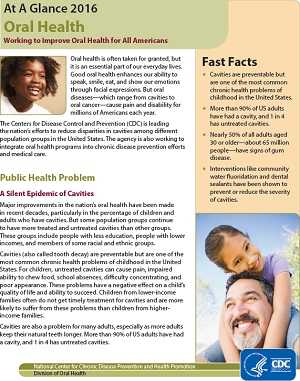Oral Health
Working to Improve Oral Health for All Americans
At A Glance 2016
Oral health is often taken for granted, but it is an essential part of our everyday lives. Good oral health enhances our ability to speak, smile, eat, and show our emotions through facial expressions. But oral diseases—which range from cavities to oral cancer—cause pain and disability for millions of Americans each year.
The Centers for Disease Control and Prevention (CDC) is leading the nation’s efforts to reduce disparities in cavities among different population groups in the United States. The agency is also working to integrate oral health programs into chronic disease prevention efforts and medical care.
Public Health Problem
A Silent Epidemic of Cavities
Major improvements in the nation’s oral health have been made in recent decades, particularly in the percentage of children and adults who have cavities. But some population groups continue to have more treated and untreated cavities than other groups. These groups include people with less education, people with lower incomes, and members of some racial and ethnic groups.
Cavities (also called tooth decay) are preventable but are one of the most common chronic health problems of childhood in the United States. For children, untreated cavities can cause pain, impaired ability to chew food, school absences, difficulty concentrating, and poor appearance. These problems have a negative effect on a child’s quality of life and ability to succeed. Children from lower-income families often do not get timely treatment for cavities and are more likely to suffer from these problems than children from higher-income families.
Cavities are also a problem for many adults, especially as more adults keep their natural teeth longer. More than 90% of US adults have had a cavity, and 1 in 4 has untreated cavities.
Interventions to Prevent Cavities
Many children and adults go without simple measures that have been proven to be effective in preventing oral diseases and reducing dental care costs. For example, fluoride prevents cavities, and water fluoridation is the most cost-effective way to deliver this benefit. Water fluoridation adjusts the fluoride in the public water supply to the appropriate level to prevent cavities. Although about 3 in 4 people on public water systems benefit from water fluoridation, about 100 million Americans still do not have access to fluoridated tap water.
Another safe, effective way to prevent cavities is with dental sealants, which are protective coatings applied to the chewing surfaces of the back teeth, where most decay occurs. Dental sealants continue to prevent over 80% of cavities 2 years after placement. Yet only about 1 in 3 children aged 6 to 8 years has sealants.
The prevalence of treated and untreated cavities varies among racial and ethnic groups, as does the use of dental sealants. In addition, children from lower-income families are almost twice as likely to have cavities as those from higher-income families, but they are much less likely to have dental sealants.
Percentage of Dental Sealants in Permanent Teeth
Among US Children Aged 6-11 Years, 2011-2012

Note: “Total” includes all US children aged 6-11 for all racial and ethnic groups combined.
Source: National Health and Nutrition Examination Survey.
Gum Disease
Another common oral condition in US adults is gum disease, also called periodontal disease. Gum disease is an infection caused by bacteria that get under the gum tissue. Toxins from bacteria and the body’s response to infection can begin to destroy the gums and bone that support the teeth. Teeth become loose, chewing becomes difficult, and teeth may have to be removed. Nearly 50% of all adults aged 30 or older—about 65 million people—have signs of gum disease.
Gum disease may also be connected to damage in other areas of the body. Studies have linked oral infections with diabetes, heart disease, stroke, and premature, low-weight births. Further research is being done to look at these connections.
CDC’s Response
The National Center for Chronic Disease Prevention and Health Promotion (NCCDPHP) works in four key areas or domains: epidemiology and surveillance, environmental approaches, health care system interventions, and community programs linked to clinical services. This comprehensive approach supports healthy choices and behaviors, makes healthier options more available, and helps Americans better manage their health.
CDC works with partners—including the Association of State and Territorial Dental Directors and other federal agencies, such as the Health Resources and Services Administration and the Centers for Medicare & Medicaid Services—to promote oral health through public health interventions. With $18 million in FY 2016 funding, CDC’s Division of Oral Health supports these efforts by working in all of NCCDPHP’s four domains.
Related Materials
Fast Facts
- Cavities are preventable but are one of the most common chronic health problems of childhood in the United States.
- More than 90% of US adults have had
a cavity, and 1 in 4 has untreated cavities. - Nearly 50% of all adults aged 30 or older—about 65 million people—have
signs of gum disease. - Interventions like community water fluoridation and dental sealants have been shown to prevent or reduce the severity
of cavities.

“Water fluoridation’s biggest advantage is that it is the best method for delivering fluoride to all members of the community regardless of age, education, income level, or access to routine dental care.”
Vice Admiral Vivek H. Murthy, MD, MBA
US Surgeon General

Epidemiology and Surveillance
CDC is the lead agency that analyzes data to monitor progress in meeting the oral health objectives in Healthy People 2020, the nation’s agenda for improving the health of all Americans. One of these objectives is to increase the proportion of children, adolescents, and adults who used the oral health care system in the past year. This objective is also one of 12 high-priority Healthy People 2020 objectives called Leading Health Indicators.
In 2015, CDC released Oral Health Data, a web-based system that brings together data from many sources in a user-friendly format. This system allows people to export data in several formats and easily create tables, charts, and maps. It includes data from the National Oral Health Surveillance System and various state sources (e.g., state oral health surveys, Behavioral Risk Factor Surveillance System surveys, biennial water fluoridation surveys).
CDC also helps state health departments collect, interpret, and share oral health data specific to their areas. States and communities use the data to monitor their progress in meeting their objectives for oral health, set funding priorities to reach people with the greatest needs, and compare their data with other states and the nation.
In addition, CDC works to improve surveillance methods. For example, measures of gum disease are expensive to collect because they require detailed clinical exams. CDC developed questions that can be added to state and local surveillance systems to measure self-reported gum disease status.
Environmental Approaches
The independent, nonfederal Community Preventive Services Task Force recommends community water fluoridation as an effective intervention for reducing cavities at the population level.
Each generation born since the use of water fluoridation has enjoyed better dental health than the generation before it. Even with the widespread use of products with added fluoride, like toothpaste, studies have found that people living in communities with water fluoridation have 25% fewer cavities than those living in communities without fluoridation.
CDC works with state and national partners to improve water fluoridation quality by providing training to state drinking water system engineers and oral health and other public health staff. The agency also manages a web-based reporting system that helps states monitor the quality of water systems. The public component of this database, My Water’s Fluoride, allows residents in participating states to learn the fluoride content of their public water system. Through this website and its partners, CDC educates people across the country on the health benefits of water fluoridation.
Health Care System Interventions
Infection control in dental offices is essential to ensuring the public’s safety and retaining its confidence. To help reduce the risk of transmitting infectious diseases, CDC published the Summary of Infection Prevention Practices in Dental Settings: Basic Expectations for Safe Care in 2016. This resource includes current infection control recommendations from CDC and a checklist to evaluate compliance.
CDC recommendations guide infection control practices in dental offices nationally and globally; provide direction for the public, policy makers, and dental practitioners; and guide technology development in the dental industry. CDC also investigates possible disease transmission in dental offices.
Community Programs Linked to Clinical Services
School dental sealant programs provide sealants to children who are unlikely to receive them in private dental office settings. These programs provide sealants at school using mobile dental equipment during the school day. They are especially effective at reaching children from low-income families.
CDC-funded programs focus on schools that serve children at high risk of cavities. CDC provides guidance to state and community programs to help them plan, set up, and evaluate school sealant programs and to complement services provided by private dentists. CDC is also creating a tool that allows states to assess the cost-effectiveness of these interventions.
CDC Funding Supports Programs and Saves Money
CDC provides 21 states with funds, technical assistance, and training to build strong oral health programs. This support helps states promote oral health, monitor oral health behaviors and problems, and conduct and evaluate prevention programs.
CDC funding also helps states improve the coordination and management of community water fluoridation programs and school dental sealant programs and develop ways to integrate dental care into medical care.
- On average, every $1 spent to fluoridate a community water system saves about $38 each year from fewer cavities treated.
- Dental sealants applied to the teeth of children at high risk of cavities saves Medicaid $6 per tooth sealed over a 4-year period.

Future Directions
CDC’s Division of Oral Health will continue to focus on promoting evidence-based interventions to reduce disparities in oral health among different population groups. The division will conduct surveillance of oral diseases and conditions, support state and tribal oral health programs, and provide guidance on infection control in dental care settings.
Another division priority is to make oral health an integral part of public health programs in the United States. Efforts will include exploring ways to coordinate with partners in chronic disease prevention, building models of integration for demonstration in state health departments, and integrating oral health with state and national health care reform efforts.
- Page last reviewed: April 13, 2016
- Page last updated: April 13, 2016
- Content source:



 ShareCompartir
ShareCompartir
